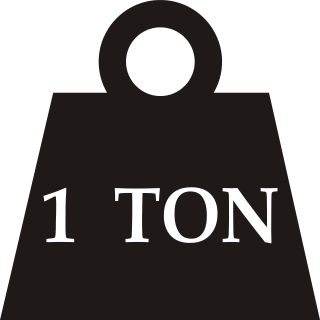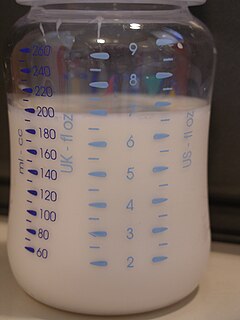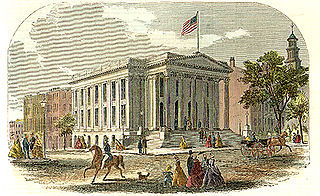Related Research Articles

The gallon is a unit of volume in imperial units and United States customary units. Three different versions are in current use:

The imperial system of units, imperial system or imperial units is the system of units first defined in the British Weights and Measures Act 1824 and continued to be developed through a series of Weights and Measures Acts and amendments.

The ton is a unit of measure. It has a long history and has acquired a number of meanings and uses over the years. It is used principally as a unit of weight. Its original use as a measurement of volume has continued in the capacity of cargo ships and in terms such as the freight ton. Recent specialized uses include the ton as a measure of energy and for truck classification. It is also a colloquial term, "ton" is the heaviest unit of weight typically used in colloquial speech. It is also used informally to mean a large amount of something, material or not.

United States customary units form a system of measurement units commonly used in the United States and U.S. territories since being formalized in 1832. The United States customary system developed from English units which were in use in the British Empire before the U.S. became an independent country. The United Kingdom's system of measures was overhauled in 1824 to create the imperial system, which was officially adopted in 1826, changing the definitions of some of its units. Subsequently, while many U.S. units are essentially similar to their imperial counterparts, there are significant differences between the systems.

In recipes, quantities of ingredients may be specified by mass, by volume, or by count.

The avoirdupois system is a measurement system of weights that uses pounds and ounces as units. It was first commonly used in the 13th century AD and was updated in 1959.

A bushel is an imperial and US customary unit of volume based upon an earlier measure of dry capacity. The old bushel is equal to 2 kennings (obsolete), 4 pecks, or 8 dry gallons, and was used mostly for agricultural products, such as wheat. In modern usage, the volume is nominal, with bushels denoting a mass defined differently for each commodity.

A barrel or cask is a hollow cylindrical container with a bulging center, longer than it is wide. They are traditionally made of wooden staves and bound by wooden or metal hoops. The word vat is often used for large containers for liquids, usually alcoholic beverages; a small barrel or cask is known as a keg.
English units are the units of measurement used in England up to 1826, which evolved as a combination of the Anglo-Saxon and Roman systems of units. Various standards have applied to English units at different times, in different places, and for different applications.

Both the British Imperial and United States customary systems of measurement derive from earlier English systems used in the Middle Ages, that were the result of a combination of the local Anglo-Saxon units inherited from Germanic tribes and Roman units brought by William the Conqueror after the Norman Conquest of England in 1066.

Weights and measures acts are acts of the British Parliament determining the regulation of weights and measures. It also refers to similar royal and parliamentary acts of the Kingdoms of England and Scotland and the medieval Welsh states. The earliest of these were originally untitled but were given descriptive glosses or titles based upon the monarch under whose reign they were promulgated. Several omnibus modern acts are entitled the Weights and Measures Act and are distinguished by the year of their enactment.
The wey or weight was an English unit of weight and dry volume by at least 900 AD, when it begins to be mentioned in surviving legal codes.
Winchester measure is a set of legal standards of volume instituted in the late 15th century (1495) by King Henry VII of England and in use, with some modifications, until the present day. It consists of the Winchester bushel and its dependent quantities, the peck, (dry) gallon and (dry) quart. They would later become known as the Winchester Standards, named because the examples were kept in the city of Winchester.
The last was a Dutch unit of mass, volume, and number, and a large English unit of weight, mass, volume, and number. It referred to standardized amounts of ships' lading and varied by commodity and over time.
Capacities of brewery casks were formerly measured and standardised according to a specific system of English units. The system was originally based on the ale gallon of 282 cubic inches. In United Kingdom and its colonies, with the adoption of the imperial system in 1824, the units were redefined in terms of the slightly smaller imperial gallon. The older units continued in use in the United States.

The imperial and US customary measurement systems are both derived from an earlier English system of measurement which in turn can be traced back to Ancient Roman units of measurement, and Carolingian and Saxon units of measure.
The quarter is used as the name of several distinct English units based on ¼ sizes of some base unit.
A firkin is a unit of volume or mass used in several situations. Its etymology is likely to be from the Middle English ferdekyn, probably from the Middle Dutch diminutive of vierde 'fourth'. Firkin also describes a small wooden cask or tub for butter, lard, etc.
A number of units of measurement were used in South Africa to measure quantities like length, mass, capacity, etc. The Imperial system of measurements was made standard in 1922 and the metric system was adopted in 1970.
The Exchequer Standards may refer to the set of official English standards for weights and measures created by Queen Elizabeth I, and in effect from 1588 to 1826, when the Imperial Units system took effect, or to the whole range of English unit standards maintained by the Court of the Exchequer from the 1200s, or to the physical reference standards physically kept at the Exchequer and used as the legal reference until the such responsibility was transferred in the 1860s, after the Imperial system had been established.
References
- 1 2 3 Robinson, William (1825). The Magistrate's Pocket-book, Or, An Epitome of the Duties and Practice of a Justice of the Peace. C. Hunter. p. 50. Retrieved 9 April 2015.
- 1 2 3 Crabb, George (1841). A Digest and Index with Chronological Tables of All the Statutes: From Magna Charta to the End of this Last. A. Maxwell & son. p. 231. Retrieved 9 April 2015.
- ↑ "Tub, n1, 1, d". Oxford English Dictionary . Retrieved 9 April 2015.
- ↑ Rowlett, Russ. "How Many? A Dictionary of Units of Measurement" . Retrieved 9 April 2015.